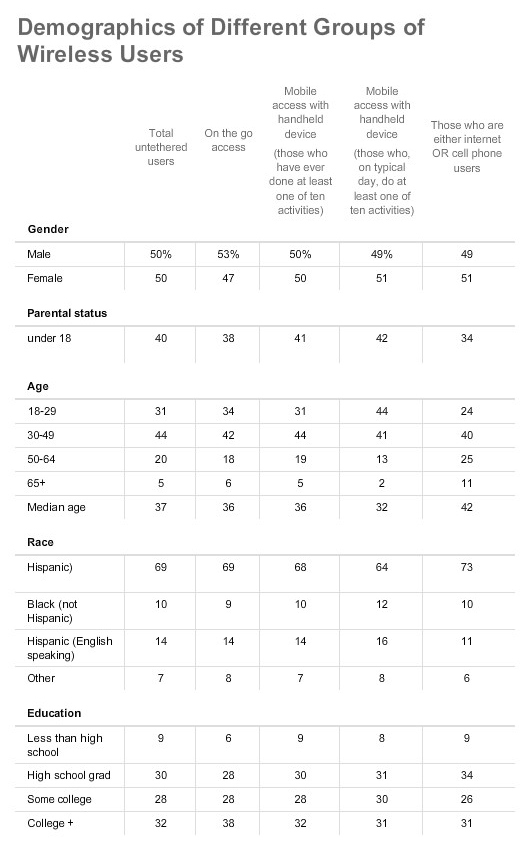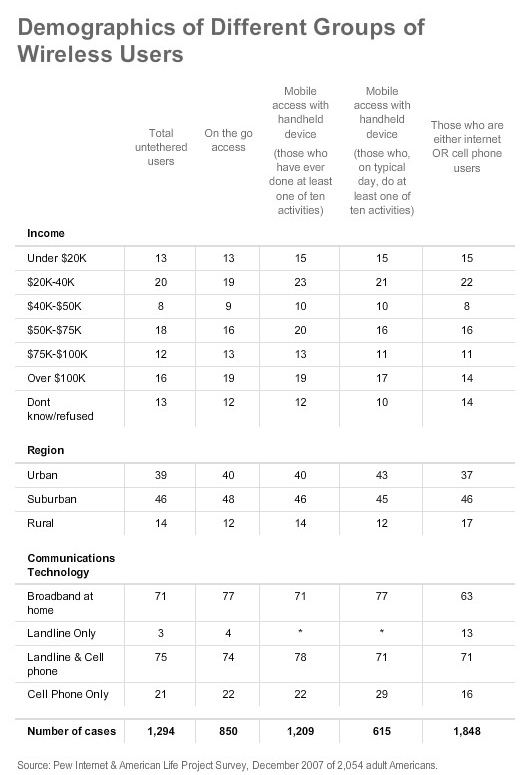62% of all Americans are part of a wireless, mobile population that participates in digital activities away from home or work
According to the Pew Internet Project’s December 2007 survey:
- 58% of adult Americans have used a cell phone or personal digital assistant (PDA) to do at least one of ten mobile non-voice data activities, such as texting, emailing, taking a picture, looking for maps or directions, or recording video.
- 41% of adult Americans have logged onto the internet on the go, that is, away from home or work either with a wireless laptop connection or a handheld device.
This comes to 62% of all Americans who have some experience with mobile access to digital data and tools. That is, they have either used a cell phone or PDA for a non-voice data application or logged on to the internet away from home or work using a wireless laptop connection or with a handheld device. The Pew Internet Project’s December 2007 survey interviewed a sample of 2,054 adult Americans, which included 500 respondents contacted on their cell phones.
Accompanying this changing nature of access – no longer slow and stationary, but now fast and mobile – has been a transformation in how people value their media access tools. When asked how hard it would be to give up a specific technology, respondents are now most likely to say the cell phone would be most difficult to do without, followed by the internet, TV, and landline telephone. This represents a sharp reversal in how people viewed these technologies in 2002.
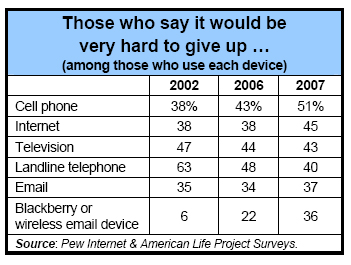
Leading the way in this world of untethered access are young adult Americans, Hispanics, and African Americans. A majority of adults under age 30 and Hispanics would find it hardest to do without their cell phones – and are much more likely to say it would be hard to be without a cell phone than to be without the internet or email. Hispanics in the United States are a more youthful group than whites or African Americans, but Latinos’ attachment to the cell phone stands out even after controlling for age and other demographic and socio-economic factors.
Non-voice data access using handheld devices
Here’s how the data breaks out for each of the ten activities asked about relating to non-voice data applications on a cell phone or PDA.
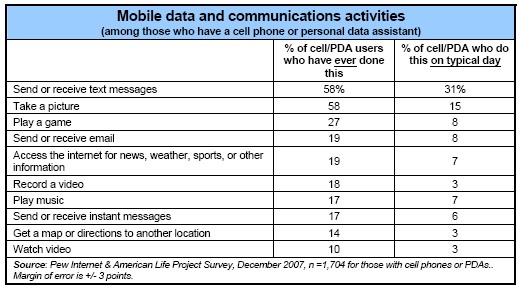
Among the 75% of Americans with either a cell phone or a PDA:
- 77% have ever done at least one of the ten listed handheld activities.
- 42% on a typical day did at least one of the ten listed handheld activities.
This comes to 58% of all Americans who have ever done one of the ten activities, with 32% of all Americans doing at least one of them on a typical day.
Defining access “on the go”
For internet access on the go, online users were asked how often they use the internet someplace other than home or work. Some 29% of internet users say they do this at least every few weeks, with 21% doing this at least a couple days a week.
We also asked remaining online users whether they had, in the previous twelve months, gone online away from home or work. Specifically, this question was directed to those who said they had infrequently used the internet away from home or work (22% of internet users) or had not done this (49% of online users).
Combining these two ways of asking about “away from home or work” online use, we find that nearly two-thirds (64%) of internet users have gone online away from home or work, which could include wired access at libraries or in hotel rooms.
Focusing more narrowly on wireless access on the go, respondents were asked whether they had used a wireless internet connection on a laptop computer, a cell phone, or a PDA.1 Adding up those who had said “yes” to any of those questions yielded the result that 52% of internet users have used a wireless connection at one time to go online away from home or work. This translates into 41% of all Americans who have logged on wirelessly away from home.
Hispanics and young adults lead the way with handheld devices
Demographically, the clearest dividing lines for the different handheld activities are age and race. For English-speaking Hispanics, the cell phone is an oft-used and multifaceted device – more so than is the case for white or black Americans.2
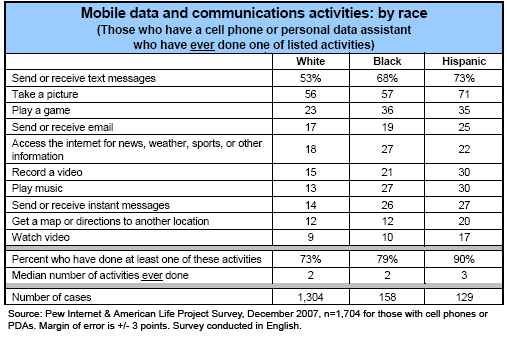
As to access to cell phone technology:
- 84% of English-speaking Hispanics have cell phones.
- 74% of white Americans have cell phones.
- 71% of black Americans have cell phones.
On a typical day, more than half of English-speaking Hispanics do something on their cell phone that might involve sending or receiving data.
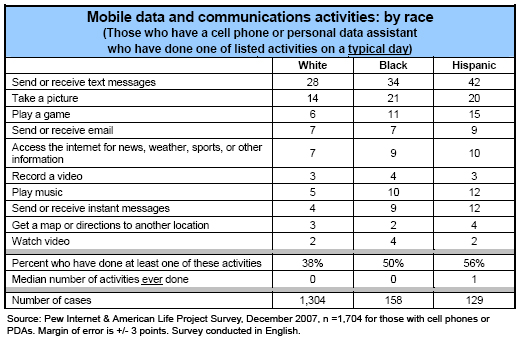
There are also differences across age groups in the use of handhelds for data applications.
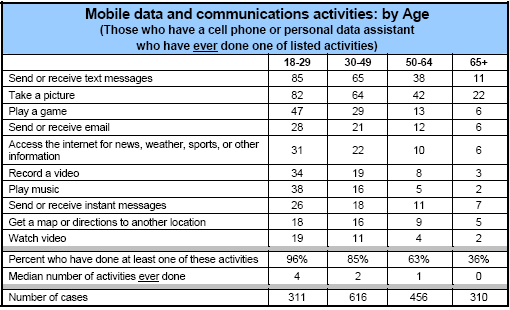
Roughly the same share of “under age 30” adults (60%) on the average day use a handheld device for text messaging as sends or receives email (62% do). These numbers suggest that, while alternative forms of digital chatter (e.g., texting) are important to young adults, email remains a part of their daily electronic communication activities, although it may be less central for young adults as other applications compete for their attention.
For English-speaking Hispanics, 42% text message on the average day, compared to 56% who check email. For black Americans, 34% send or receive a text message on the typical day, while 57% say they send or receive email.
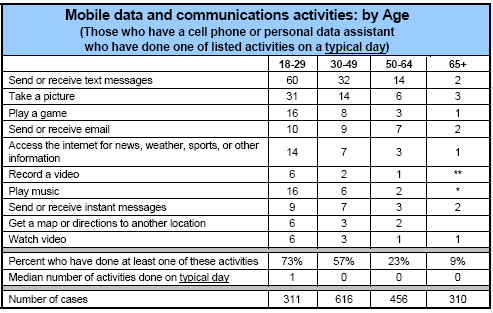
Hispanics and young adults also lead the way for “on the go” away from home or work.
Similar differences by age and race are evident for wireless access away from home or work using a laptop computer. Against the average of 52% of internet users who have used a laptop or handheld to connect to the internet wirelessly away from home or work:
- 65% of English-speaking Hispanic internet users have done this.
- 54% of African American internet users have done this.
- 49% of white internet users have done this.
Looking at different age groups, among internet users:
- 70% of online users between the ages of 18 and 29 have logged on wirelessly away from home or work using a laptop computer.
- 53% of online users between ages 30 and 49 have logged on wirelessly away from home or work using a laptop computer.
- 39% of online users between ages 50 and 64 have logged on wirelessly away from home or work using a laptop computer.
- 29% of online users over age 65 or older have logged on wirelessly away from home or work using a laptop computer.
Most Hispanics and young adults say cell phones would be very hard to give up.
With handheld access or laptop access on the go routine for so many people – and especially young adults and Hispanics – it is not a surprise that they are likely to say it would be very hard to give up their cell phones or internet access. In fact, more than half (54%) of Hispanics said they would find it very hard to give up their cell phones – a higher share than said it would be very hard to give up the internet. Half (51%) of African Americans say it would be very hard to give up their cell phones, a significant difference from the share who say this about the internet (37%).
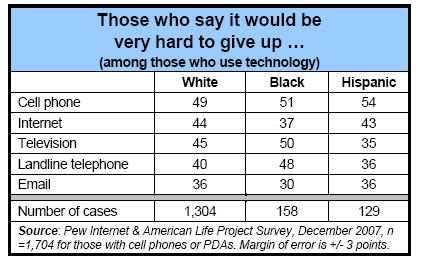
For young adults, close to two-thirds (62%) say it would be very hard to do without a cell phone, more than the half (51%) who say that about the internet and more than twice the share that feels this way about the plain old landline telephone.
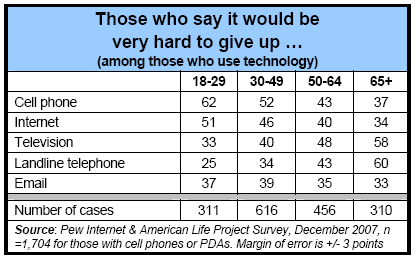
For the most part, untethered access is not a substitute for online access at home
The vast majority of people who have accessed digital data or tools on the go are internet users. Among this group, fully 91% count themselves as internet users. Among the remaining 9%, this group demographically tilts toward African American men in their 40’s with low incomes. Within this group, 24% have household incomes that of $25,000 annually or less, 25% are African American, and more than half are men. All have cell phones, and members of this group are more likely to have cell phones only as their means of telephone access than the general population (by a 30% to 21% margin).3
